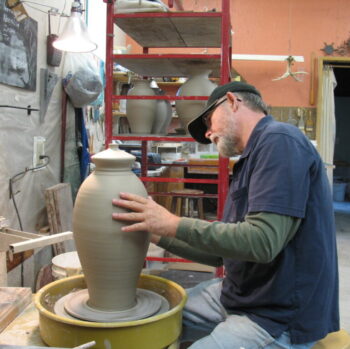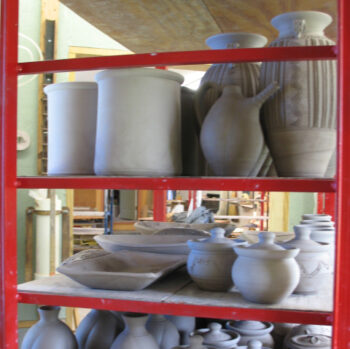About
We are Whynot Pottery, we moved to Whynot NC in 1976 to live on the family farm and raise small livestock. We ended up fully embracing the pottery of the Seagrove area. Working together for the past forty years we have developed a style of work and palette of glazes to complement the clay beneath.
Acacia Art Tile came about in 2009. It was a concept first put together by Meredith and her sister Lee Lewis. After the loss of her sister Lee, Meredith slowly worked into the tiles on her own. All the tiles are hand-rolled and hand-cut, after drying and firing, they are decorated to create images of the things around us, flowers from the garden, praying mantis, lizards, an added layer of tiles are the giraffes and sheep, with a whimsical point of view they have quickly become favorites.


Why Whynot?
Until 1905 much of the area in North Carolina that is now called Seagrove was known as Whynot.
In about 1854 the people of the community found themselves in need of an official name in order to establish a federal post office. During a meeting called to address this many suggestions were considered. Each prospective name was preceded with the question “Why not?”
Since no one was willing to answer that question, or agree on a name, the meeting dragged on late into the night. After hours of polite indecision, one brave and tired soul stood up and said, “Why not call it Whynot and let’s go home.”
If you know of another community or pottery named Whynot please e-mail me and tell me where it is and what you know of it. So far the only other Whynot I know is in Mississippi just south of Interstate 20 at the Alabama state line. And I still haven’t heard their story .
process
We just make pots, pots for pouring, pots for drinking, pots to serve from, pots to eat from, pots that are candles, and pots that are lamps.
We start with high-quality pre-mixed clay and form our pots on the wheel and occasionally with clay either rolled or extruded. After drying the work is fired to about 1800 degrees Fahrenheit; what we’d call bisque temperature. At this point, the work is ready to glaze.
Glazes are applied by either dipping the pots, pouring or spraying the glaze and sometimes a combination of each.
All of our pottery glazes are mixed on-site and made up mostly of feldspar, flint, clay, calcium carbonate, and wood ashes. Metallic oxides (mostly iron) are added for color.
We never use lead in our pottery.
Glaze firing
It takes ten to twelve hours to bring the interior temperature of our LP gas fired kiln to 2350o and two full days for the ware inside to cool enough to be handled.